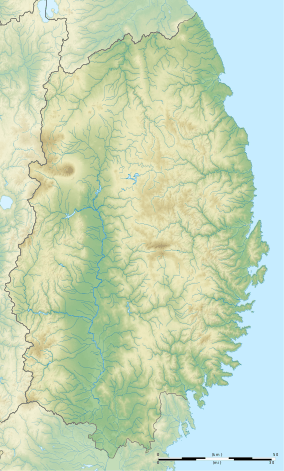Takonoura Shell Mound
| 蛸ノ浦貝塚 | |
 Location in Japan  Takonoura Shell Mound (Japan) | |
| Location | Ōfunato, Iwate, Japan |
|---|---|
| Region | Tōhoku region |
| Coordinates | 39°02′08″N 141°44′23″E / 39.03556°N 141.73972°E |
| Altitude | 31 m (102 ft) |
| Type | shell midden |
| History | |
| Periods | Jōmon period |
| Site notes | |
| Ownership | National Historic Site |
| Public access | Yes |
Takonoura Shell Midden (蛸ノ浦貝塚 Takonoura kaizuka) is a Jōmon period archaeological site consisting of a shell midden and the remains of an adjacent settlement located in what is now the city of Ōfunato, Iwate Prefecture in the Tōhoku region of northern Japan. It is protected by the central government as a National Historic Site.[1]
The rocky rias coast of Iwate Prefecture was densely settled from the early through late Jōmon period, and the locations of such coastal settlements are often marked by shell middens containing shellfish, fish, animal and whale bones and human-produced artifacts, including earthenware shards, fishing hooks, etc. In particular, the deeply indented Ōfunato Bay area was a rich fishing ground and is the location of 16 known Jomon-period shell middens, a number of which have been designated National Historic Sites.
The Takonoura Shell Midden dates from the early to middle Jōmon period, and is located on a hill on the east side of the Ōfunato Bay. It was partially excavated in 1957 by Waseda University. The midden is annuar, but truncated to the east and southweast, and has a thickness of over two meters. An unusual feature is that some layers consist almost exclusively of a certain type of artifact (for example, only oyster shells, or only fish bones, etc). However, in general, the midden has a typically mixed composition including many varieties of shellfish, fish bones, and the bones of mammals such as dogs, Sitka deer, whales, wolves and dolphins. In addition, stone axes, weights, and carved bone objects, such as fishhooks, and bone jewelry have been found. The site also contains traces of dwelling foundations and eight sets of human remains.
See also
References
External links
- Iwate Prefecture site (in Japanese)
- Ofunato city home page (in Japanese)